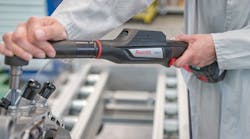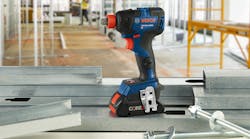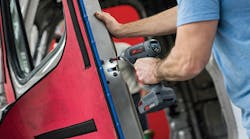Latest from Plant Operations
Tightening Solution Provides Advanced Wireless Technology
Industry 4.0 is already the hot topic at plants across the globe, and it's still coming of age; even experts are learning something new about it every day. It's impossible to know everything about it with so many companies unveiling new smart solutions, and trying to figure out exactly what will be useful is even more difficult.
First, you have to decide what issue the IIoT needs to solve, and then how it's going to do that. These vary widely, so from the manufacturer's perspective, product flexibility is the most important trait.
This is the defining feature of the Nexo cordless Wi-Fi nutrunner from Bosch Rexroth. Using an onboard control unit, the battery-powered fastening tool ensures accurate measurements of torque and angle of rotation by measuring and recording these values during operation, making it a versatile tool for several applications.
We asked Dan Cejka, Bosch Rexroth's Product Engineering and Sales Manager for Joining Technologies, why this new smart tool stands out in the crowded field.
NED [New Equipment Digest]: What is the Nexo and what industry/workers will use it?
DC [Dan Cejka]: The Bosch Rexroth Nexo wireless nutrunner was developed for industrial applications where ergonomic assembly of safety or function-critical fastening is required. Nexo is state-of-the-art—often referred to as intelligent—fastening technology where electronic sensors continuously monitor the torque and angle while controlling tool speed and tool reaction. These products are typically used in high-volume manufacturing such as automotive, aerospace, RV, motorcycle/ATV, and marine.
NED: What are the main features of the Nexo?
DC: The Nexo provides wireless Li-Ion-powered, intelligent fastening via its fully integrated controller and digital torque/angle transducers. This means it can tighten up to 256 different products and record the results and torque curves automatically to satisfy quality control requirements. It further features integrated Wi-Fi support providing the ability to fully interact with the factory network or other i4.0-related software/hardware.
NED: What's your favorite feature and why?
DC: The fully integrated tightening controller with color HMI display would be my pick. This is a game changer because it allows the tool to be used in wireless dead spots or completely independent of a factory control system without any loss of functionality or operator feedback. The full-color display is interactive, allowing the operator to choose programs, review results, receive work instructions, images, messages, etc. Nexo is really unmatched in its flexibility.
NED: How is the Nexo different than similar wireless tools?
DC: Other wireless tools require a connection to an external controller. As a result, they do not work well in areas with poor or no wireless signal. They are also subject to range issues on networks such as Bluetooth or when moving around the production assembly.
Nexo avoids these problems via the fully integrated controller and onboard memory. It can work as long as needed without connectivity and transmits results when back in range. By including a full-color HMI directly on the tool, the operator also has a clear advantage in that all the information needed is directly in their hands, so they can remain focused and efficient.
NED: In pilot projects, what did you find were the most useful features of Nexo?
DC: When developing the wireless Nexo, Rexroth knew it wanted to remove the tool cable to improve flexibility. But, we knew we could do more if we completely integrated the controller into the nutrunner. This would allow us to remove the cost/space requirements and the installation complexity of an external controller, while drastically improving the startup time from unboxing to production.
With Nexo, users can insert a battery, assign an IP address, and begin fastening within minutes. The onboard controller also allows for extremely flexible deployment, as you can quickly move tools without the need to rewire and relocate traditional external controllers.
NED: When was NEXO developed and what specific manufacturing challenges is it meant to solve?
DC: The Nexo line was released about three years ago and has expanded its capabilities with development to increase its operating range, speed, runtime, and functionality. Rexroth has also developed i4.0 software solutions to collect, analyze, and interpret data as well as provide graphic worker guidance. All these enhancements are focused on providing enhanced ergonomic options to wired intelligent tools.
NED: Anything else you would like to add that readers might find interesting?
DC: While Nexo is a Wi-Fi-based tool, it is used where there is no Wi-Fi on-site in a variety of applications. In these instances, the tool can connect to a cell phone hot spot, providing full wireless programming, diagnostics, and even data collection or commissioning. This is a great way to connect wirelessly—even if no wireless signal is present.













